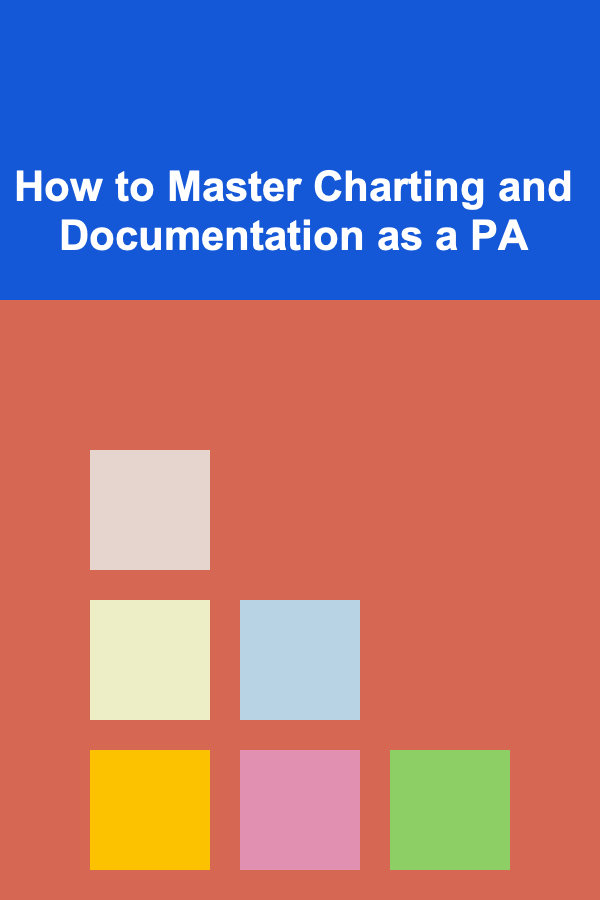
How to Master Charting and Documentation as a PA
ebook include PDF & Audio bundle (Micro Guide)
$12.99$10.99
Limited Time Offer! Order within the next:

As a Physician Assistant (PA), one of the most crucial aspects of your job involves charting and documentation. This process ensures that the patient's medical record is accurate, comprehensive, and up-to-date. Proper documentation is not just a legal requirement but also a critical component of providing quality care. Whether you're working in a hospital, outpatient clinic, or specialty setting, mastering charting and documentation is essential for effective communication, patient safety, and adherence to legal and ethical standards.
In this article, we will explore how to master charting and documentation as a PA. We'll break down the essential elements, strategies for success, and tips for improving your documentation skills.
The Importance of Charting and Documentation
Before diving into the details, it's important to understand the significance of charting and documentation. Here are some reasons why it matters so much in the PA profession:
1. Patient Safety and Care Continuity
Charting ensures that there is a clear and accessible record of each patient's medical history, treatments, and progress. This allows any healthcare provider involved in a patient's care to be fully informed, which is vital for continuity of care. Proper documentation prevents errors in medication, treatment plans, and diagnoses.
2. Legal Protection
Medical records can be used as evidence in the event of a legal dispute. Well-documented charts protect healthcare providers by serving as proof of the care provided, the patient's condition, and the steps taken in the treatment process. This makes accurate charting essential for minimizing liability.
3. Insurance and Reimbursement
Insurers rely heavily on documentation to verify that medical procedures are necessary and appropriate for reimbursement. Inadequate or incomplete documentation can result in delayed or denied payments, leading to financial difficulties for healthcare providers.
4. Quality Improvement and Research
Accurate charting contributes to evidence-based medicine and quality improvement initiatives. By documenting patient outcomes, interventions, and treatment responses, PAs help collect data that can be used for research purposes, improving the overall healthcare system.
Given these factors, it's clear that mastering charting and documentation is a skill that every PA must develop. So, let's break down the process and provide a guide for success.
The Basics of Charting and Documentation
Charting and documentation encompass several components. Understanding how to document each element accurately and thoroughly is key to mastering this skill. Below are the main components you'll encounter in a patient's medical record:
1. The History
The patient's medical history is one of the first things you will document. A thorough and accurate history provides essential context for making clinical decisions. The history includes:
- Chief Complaint (CC): A brief statement of the reason the patient is seeking medical care.
- History of Present Illness (HPI): A detailed narrative of the patient's current illness, symptoms, and relevant medical history.
- Past Medical History (PMH): A summary of the patient's previous illnesses, surgeries, and conditions.
- Medications: A complete list of current medications, including over-the-counter and prescription drugs.
- Allergies: Known allergies to medications, foods, or environmental factors.
- Social History (SH): Information about the patient's lifestyle, including occupation, family dynamics, smoking, alcohol use, and exercise habits.
- Family History (FH): A record of relevant hereditary conditions and diseases in the patient's family.
- Review of Systems (ROS): A system-by-system review to uncover additional symptoms or concerns that might not have been discussed in the HPI.
2. Physical Examination (PE)
The physical exam is another vital part of patient documentation. It includes the provider's observations and findings from their physical assessment of the patient. It typically consists of:
- General Appearance: Overall physical appearance, including distress level, hygiene, and mobility.
- Vital Signs: Blood pressure, heart rate, temperature, respiratory rate, and oxygen saturation.
- Systematic Examination: A thorough assessment of all body systems (cardiovascular, respiratory, gastrointestinal, musculoskeletal, neurological, etc.).
- Findings: Positive or negative findings from the exam, including abnormal findings that may require further investigation or treatment.
3. Assessment
The assessment is your professional evaluation of the patient's condition. It is based on the information gathered in the history and physical exam. Your assessment may include:
- Diagnoses: A list of possible or confirmed diagnoses, usually categorized as differential diagnoses when further testing is needed.
- Problem List: A prioritized list of medical issues that need attention, which can guide further treatment decisions.
- Clinical Reasoning: The thought process behind your diagnosis, including any relevant tests, imaging, or lab results.
4. Plan
The plan outlines the next steps in the patient's care. This can include diagnostic tests, treatments, referrals, medications, and follow-up care. Be specific and clear about the plan to ensure the patient receives the necessary care. The plan may consist of:
- Diagnostic Tests: Lab work, imaging, and other diagnostic tests.
- Therapeutic Interventions: Medications, procedures, or therapies recommended for the patient.
- Patient Education: Guidance on managing their condition, including lifestyle changes or self-care instructions.
- Follow-Up Care: When and how the patient should follow up for further evaluation or treatment.
Mastering Charting: Best Practices for PAs
Now that we've covered the basics, let's explore some best practices to help you master charting and documentation. Here are ten practical tips to improve your documentation skills.
1. Be Clear and Concise
Medical documentation must be clear and to the point. Avoid unnecessary jargon or lengthy explanations. Focus on essential details and ensure that your charting is easy to understand for other healthcare professionals who may need to review it.
2. Use Standardized Terminology
Consistency in the use of terminology is key to preventing confusion and ensuring accurate communication. Familiarize yourself with the common abbreviations, acronyms, and medical terminology used in your field. However, always use complete phrases when in doubt, as abbreviations can sometimes lead to misinterpretation.
3. Document in Real-Time
Whenever possible, document during or immediately after your interaction with the patient. This ensures that you capture the most accurate and up-to-date information. If you wait too long to document, you may forget key details or fail to remember the context in which decisions were made.
4. Follow the SOAP Format
The SOAP (Subjective, Objective, Assessment, and Plan) format is a widely used structure for documenting patient encounters. Organize your notes by following this format:
- Subjective: The patient's reported symptoms, including the HPI, ROS, and pertinent history.
- Objective: The clinical findings from your physical exam, labs, and diagnostic tests.
- Assessment: Your clinical interpretation and diagnosis based on the subjective and objective findings.
- Plan: The treatment plan and follow-up recommendations.
5. Ensure Accuracy and Completeness
Accuracy is paramount in medical documentation. Double-check all information, especially when it comes to medication dosages, diagnoses, and lab results. Missing or incorrect details can have serious consequences for patient care.
6. Be Objective and Neutral
It's important to remain objective and neutral in your charting. Avoid making subjective or biased comments. Document facts, findings, and your clinical reasoning. Keep personal opinions or assumptions out of the record.
7. Use EHR Systems Effectively
Most healthcare institutions now use Electronic Health Records (EHR) systems. While these systems can help streamline the documentation process, they also require a good understanding of how to navigate them efficiently. Take the time to familiarize yourself with the system's features, including templates, drop-down menus, and shortcuts.
8. Practice Good Time Management
Charting can be time-consuming, but it is an essential part of the job. Learn to manage your time efficiently by setting aside dedicated moments during or after each patient encounter to update their record. Avoid leaving documentation to the end of the day, as this can lead to delays or incomplete records.
9. Collaborate with Other Healthcare Providers
When working in a team-based setting, ensure that your documentation reflects your collaboration with other providers. This includes noting any consultations, referrals, or shared decisions regarding the patient's care. Clear communication among team members improves patient outcomes and enhances the quality of care.
10. Maintain Confidentiality
Patient records are protected by strict privacy laws, such as the Health Insurance Portability and Accountability Act (HIPAA). Always ensure that you protect patient confidentiality by following institutional guidelines for handling, storing, and sharing medical records.
Common Pitfalls to Avoid
While mastering charting and documentation, there are several common pitfalls that PAs should avoid:
1. Overuse of Abbreviations
While abbreviations can be time-saving, overusing them can lead to confusion. Always ensure that your abbreviations are widely accepted and that they are clearly understood by everyone who may review the chart.
2. Incomplete or Vague Documentation
Leaving out important details or using vague language can lead to poor communication and misinterpretation of the patient's condition. Always document fully, even if the information seems insignificant at the time.
3. Failure to Document Communication with Patients
It's important to document any communication with patients, including instructions, informed consent, and discussions about treatment plans. This protects both the patient and the provider in case of disputes or questions later on.
4. Underestimating the Importance of Follow-Up
Failing to document follow-up care or instructions can lead to missed appointments, unaddressed concerns, or uncoordinated care. Always include clear instructions regarding follow-up and the next steps in the patient's care.
Conclusion
Mastering charting and documentation is an ongoing process for every Physician Assistant. By adhering to best practices, staying organized, and focusing on accuracy, you'll ensure that your patient records are not only legally sound but also contribute to improved patient care. This skill is fundamental for effective communication, patient safety, and professional success. The more you practice and refine your documentation abilities, the more efficient and confident you will become in your role as a PA. Remember, excellent charting is not just about following rules -- it's about contributing to the overall quality of care you provide to your patients.
Reading More From Our Other Websites
- [Metal Stamping Tip 101] How to Manage Tool Inventory and Forecast Die Replacement Cycles in High‑Volume Stamping
- [Personal Financial Planning 101] How to Maximize Your Income Streams for Financial Growth
- [Organization Tip 101] How to Create a Cozy and Organized Guest Room
- [Home Holiday Decoration 101] How to Create a Cozy Holiday Atmosphere in Your Living Room
- [Organization Tip 101] How to Use Picture Frames for Functional Organization
- [Skydiving Tip 101] Elevating Confidence: Skydiving as a Powerful Tool for Personal Growth
- [Organization Tip 101] Why You Need to Consider Ergonomics in Your Home Office Setup
- [Organization Tip 101] How to Create a DIY Pantry Door Organizer
- [Home Budget 101] How to Manage Your Home Budget During Job Transitions
- [Organization Tip 101] Benefits of Installing an Emergency Power Generator for Homeowners

How to Prioritize Website Features Based on User Needs
Read More
How to Use Duct Tape for Quick Repairs on Sports Gear
Read More
The Environmental Consultant's Guide: Strategies for Sustainable Solutions
Read More
Why Organizing Your Travel Essentials Reduces Stress
Read More
How to Develop a Blockchain for Auditable Voting Systems
Read More
How to Quarantine New Fish: A Complete Checklist
Read MoreOther Products

How to Prioritize Website Features Based on User Needs
Read More
How to Use Duct Tape for Quick Repairs on Sports Gear
Read More
The Environmental Consultant's Guide: Strategies for Sustainable Solutions
Read More
Why Organizing Your Travel Essentials Reduces Stress
Read More
How to Develop a Blockchain for Auditable Voting Systems
Read More